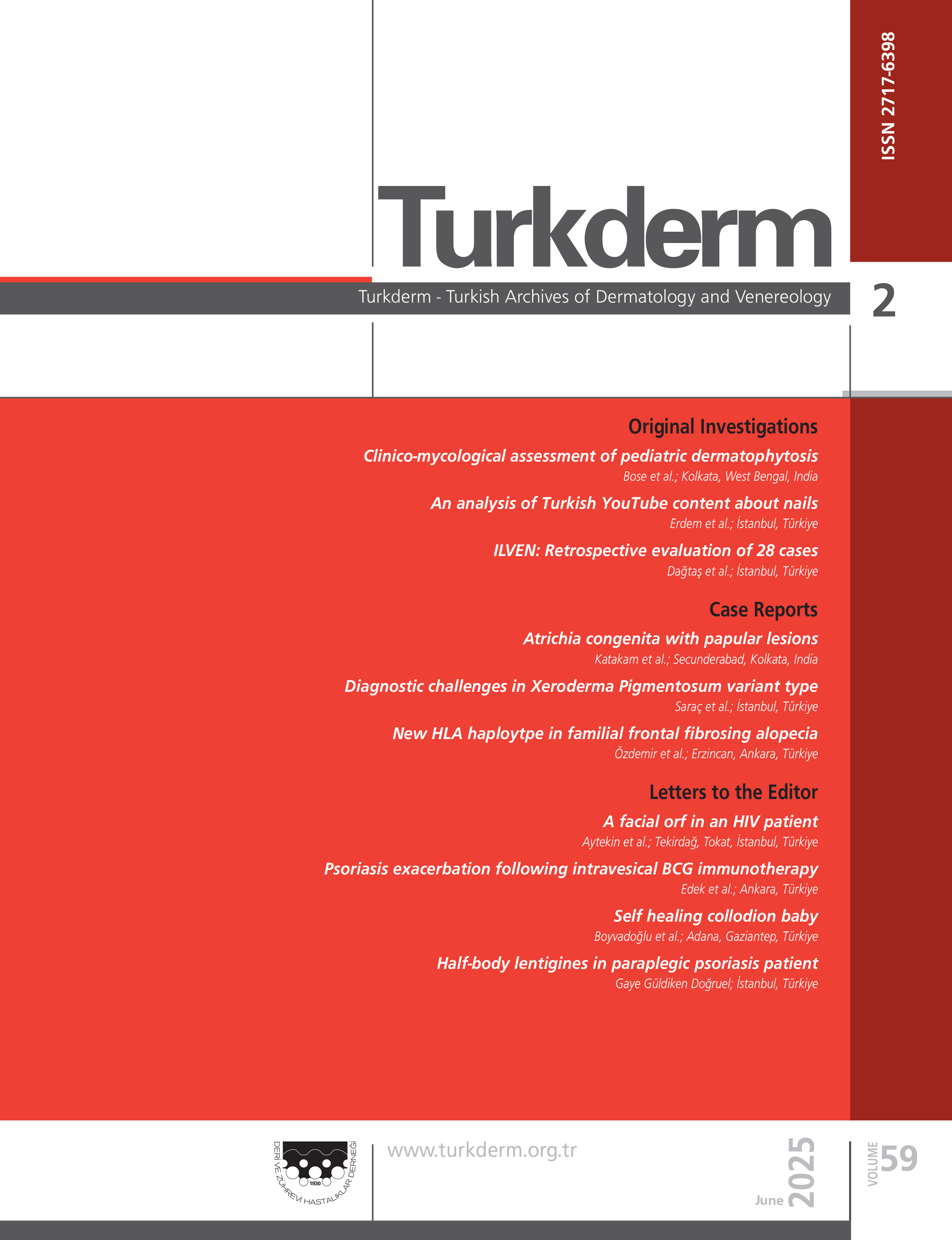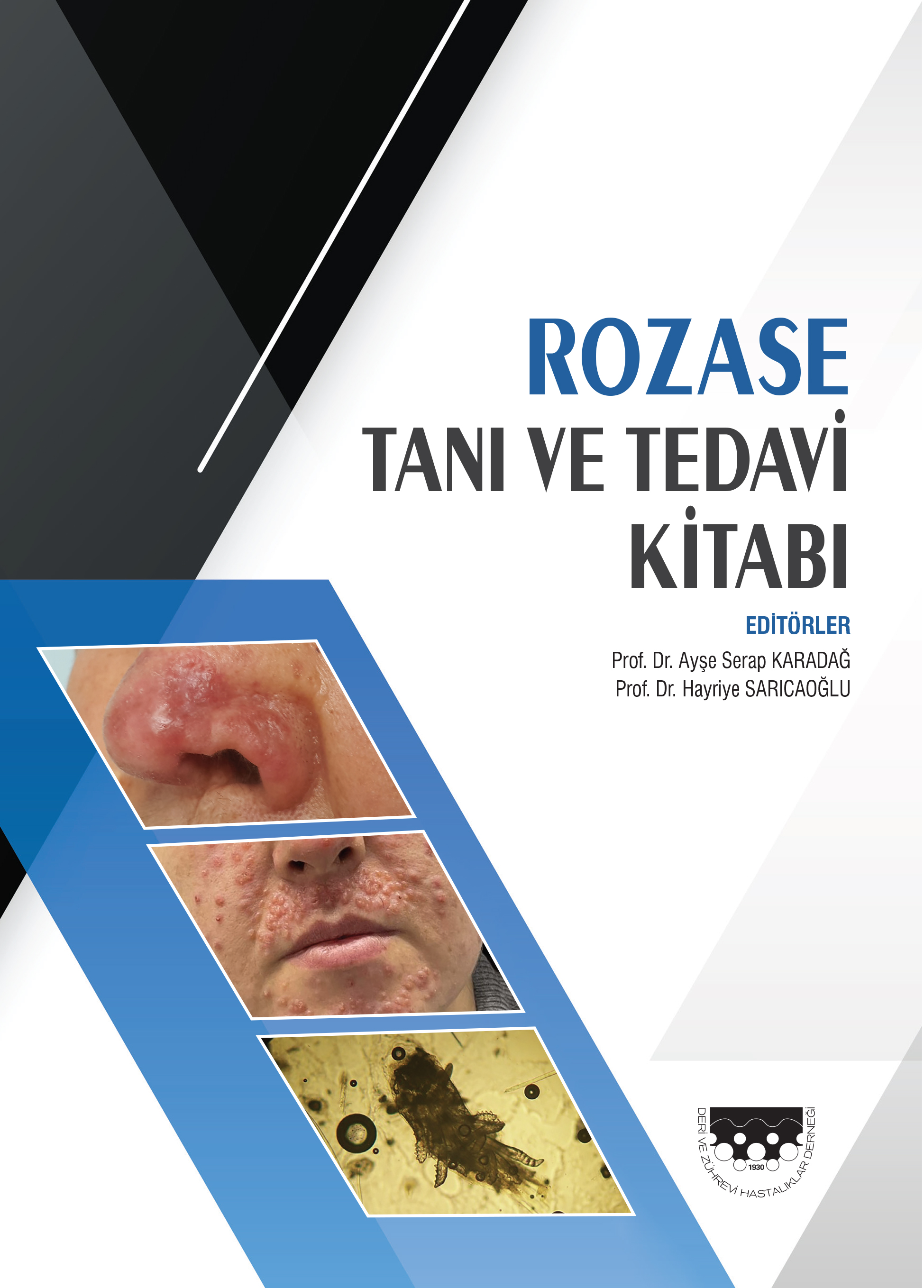Volume: 45 Issue: 4 - 2011
| EDITORIAL | |
| 1. | Dermatoscopy: Where are we heading? Sedef Şahin Page 167 Abstract | |
| REVIEW ARTICLE | |
| 2. | Atopic Dermatitis Sibel Alper, Bengü Gerçeker Türk doi: 10.4274/turkderm.80958 Pages 168 - 173 Atopic dermatitis is one of the important public health problems of the industrialized communities, and the prevalence of the disease has been increasing in our developing country. In this paper, etiopathogenesis, clinical characteristics and current therapeutic approaches of atopic dermatitis is reviewed under highlights of recently published guidelines and the literature. |
| ORIGINAL INVESTIGATION | |
| 3. | Genitourinary Infections in Female Patients with Psoriasis: Demographic and Clinical Features Sevgi Akarsu, Turna İlknur, Ceylan Canbaz Avcı, Saim Çarşanbalı, Özlem Özbağçıvan, Emel Fetil, Ali Tahsin Güneş doi: 10.4274/turkderm.60963 Pages 174 - 178 Background and Design: It has been reported that the focal infections may trigger the formation and/or exacerbation of psoriasis lesions. Although it is known that the most frequent association is with throat infection, it is emphasized that urinary tract infections should be considered as a triggering factor due to improvement of psoriatic lesions after treatment of active or asymptomatic urinary tract infection in some cases. The aim of our study was to evaluate the frequency of genitourinary infection (GUI) and to compare the clinical and demographic features of cases with and without GUI. Materials and methods: In this retrospective study, the files of 144 female psoriasis vulgaris inpatients were evaluated for clinical type of psoriasis, demographic data, psoriasis area and severity index (PASI), and accompanying GUIs. Clinically, the patients with plaque psoriasis were defined as stable psoriasis, while those with guttate psoriasis or with flare-up of guttate psoriasis in case of plaque psoriasis were defined as active psoriasis. Results: Out of a total of 144 psoriasis patients, 93 (64.4%) were in the active group and 51 (35.4%) were in the stable group. Of all the patients, 48 (33.3%) had GUI. Thirty-one (21.5%) patients had urinary tract infection, 23 (16%) had vaginitis and 5 (3.5%) patients had cervicitis. It was found that the patients with GUI had lower mean age of psoriasis onset, shorter mean duration of the last exacerbation and higher values of mean PASI compared to those without GUI. In patients with active psoriasis, the frequency of GUI was higher (36.6%) than in the stable group (27.5%), but statistically significant difference between them was not determined. Conclusion: We assumed that it would be beneficial to investigate GUI in both active and stable psoriasis cases, especially in patients who had recently suffered an exacerbation or had high clinical severity scores. |
| 4. | Clinical Evaluation of Inpatients with Acute Urticaria Ayşe Serap Karadağ, Serap Güneş Bilgili, Ömer Çalka, Necmettin Akdeniz, Hatice Uce Özkol, Siraç Aktar doi: 10.4274/turkderm.82653 Pages 179 - 183 Background and Design: To determine the clinical and etiological features of inpatients with acute urticaria and angioedema and to assess the need for laboratory tests. Material and Methods: We recruited 105 patients with acute urticaria and angioedema who were admitted to our inpatient unit. The lesions and the characteristics of the patients were analyzed. Routine diagnostic tests including complete blood count, thyroid function tests, hepatitis panel, stool parasite, total IgE levels, cultures, erythrocyte sedimentation rate, C-reactive protein, anti-nuclear antibody, and posterior anterior lung X-ray were ordered. A psychiatric consultation was obtained, when needed. The results were analyzed with SPSS 15.0 statistical software. Results: Among 105 patients, 28 (26.7%) had urticaria, 7 (6.7%) had angioedema, and 70 (66.7%) suffered from both urticaria and angioedema. The most common accompanying symptoms were itching (91.4%) and burning (34.3%). The most common systemic symptoms were fatigue (15.2%) and headache (12.4%). The lesions usually appeared in the evening hours (24.8%). Twenty-five patients were waking up due to itching during the night. Some lesions were associated with physical activities. Systemic diseases accompanied the lesions in 12 patients (11%). In terms of etiological factors, 33 patients (22.5%) had infections. Food- related lesions were encountered in 14 (13%) patients. Thirty patients (28.5%) had history of medication use. Stress was detected in 37.1% of the patients; anxiety was diagnosed in 3% of patients. The stool was positive for parasites in 10 (9%) patients. Conclusion: Acute urticaria is a benign disorder. Although the underlying cause of urticaria can not always be identified, infections and medications are the most common causes. A comprehensive and detailed history is very important to discover the underlying cause. The diagnostic tests should be ordered according to the patients history. Conducting diagnostic tests without considering the medical history of the patient leads to waste of time and resources. |
| 5. | Evaluation of Skin Findings in Adult Obese Dermatology Outpatients Hilal Kaya Erdoğan, Gonca Gökdemir, Sevim Purisa, İlknur Kıvanç Altunay doi: 10.4274/turkderm.83446 Pages 184 - 187 Background: The relationship between systemic diseases and obesity is well-known, but the dermatological effects of obesity are ignored. In the literature, a few articles have appeared concerning the skin findings related to obesity. Our objective was to evaluate the skin findings in obese patients who applied to dermatology outpatient clinic and to compare obese and non-obese outpatients. Material and Method: A total 640 patients (300-in study group, 340-in control group) were included in the study. All subjects were asked questions about socio-demographic features and presence of coexisting systemic diseases. Body mass index was calculated, dermatologic examination was performed, and diagnosis was recorded. Data were evaluated statistically. Results: Three-hundred obese patients (study group; 229 females, 71 males, mean age: 45.89 years) and 340 non-obese outpatients (control group; 160 females, 180 males, mean age: 38.99 years) were included in our study. There were more females in the study group and the mean age was higher than the control group. Most common skin findings of obese patients were: Skin tag (53.3%), plantar hyperkeratosis (29.6%), fungal infections (25.3%), striae (20.3%) and acanthosis nigricans (15.3%). Fungal infections, intertrigo, varicose veins and keratosis pilaris were more common in females than males in the study group. Within the study group, patients with skin tag, acanthosis nigricans and plantar hyperkeratosis had higher BMI. Conclusion: Skin tag, plantar hyperkeratosis, fungal infections, striae and acanthosis nigricans were found to be the most common skin diseases in obese patients in our study. Studies related with pathophysiologic features of the skin of obese patients will give more information about the development and treatment of these diseases. |
| 6. | Investigation of the Relationship Between Molluscum Pendulum and Impairment of Carbohydrate Metabolism Murat Kemal Harbutluoğlu, Göksun Karaman, Neslihan Şendur, Ekin Şavk, Meltem Uslu, Çiğdem Yenisey, Engin Güney doi: 10.4274/turkderm.75418 Pages 188 - 192 Background and Design: High blood sugar level, insulin resistance and dyslipidemia are accepted to be indicators of impaired carbohydrate metabolism. The potential role of these markers as well as the serum levels of insulin growth factor (IGF-1) and insulin growth factor binding protein (IGFBP-3) in the pathogenesis of molluscum pendulum were investigated in this study. Materials and methods: Forty-five molluscum pendulum patients and 45 age-, sex- and body mass index-matched healthy individuals as controls were enrolled in the study. Evaluation included dermatological examination, measurement of insulin resistance using HOMA-IR method, lipid profile, fasting blood glucose, postprandial blood glucose, fasting insulin, postprandial insulin, serum IGF-1 and IGFBP-3 levels. Results: Postprandial blood glucose, fasting insulin, postprandial insulin and Homeostazis Model Assesment (HOMA-IR) levels of molluscum pendulum patients were statistically higher than those of controls (p=0.037, p=0.027, p=0.03, p=0.021 respectively), whereas serum IGF-1 and IGFBP-3 levels were significantly lower than those of controls (p=0.008, p=0.001). There was no difference in fasting glucose and lipid profile between the two groups. Three patients (6.7%) had DM and one patient (13.3%) had impaired glucose tolerance. Only one participant from the control group (2,2%) had impaired glucose tolerance. The number of molluscum pendulum lesions correlated with fasting glucose, postprandial glucose, fasting insulin, postprandial insulin, HOMA-IR, total cholesterol and triglyceride levels. Conclusion: Molluscum pendulum patients should have blood glucose and insulin resistance measurements done and be followed up for DM. Patients with multiple lesions need to be evaluated for lipid problems. We suggest that serum IGF-1 and IGFBP-3 levels have no role in the pathogenesis of molluscum pendulum. |
| 7. | Dermoscopic Features of Acral Melanocytic Nevi Filiz Canpolat, Havva Kaya Akış, Bengü Nisa Akay, Cengizhan Erdem doi: 10.4274/turkderm.04568 Pages 193 - 197 Background and Design: Compared to nevi in other regions, acral melanocytic nevi have special dermoscopic features due to their anatomical localizations. It may be difficult to distinguish the melanocytic nevi in these regions from early acral melanoma. For this reason, it is important to know the dermoscopic patterns of acral melanocytic nevi. Our aim was to evaluate the dermoscopic patterns and distribution features of acral melanocytic nevi. Material and Method: One hundred ninety-six acquired acral melanocytic nevi of 131 patients were evaluated retrospectively in this study. The demographic features such as age and sex, localization and pattern of nevi were recorded. Results: Of the 131 patients, 77 (58.7%) were female and 54 (41.3%) were male. Of all nevi, 92 (46.9%) were present on the palms, 104 (53.1%) were present on the soles. The localizations of acral nevi were as follows: inner arch (20%), finger (18.4%), hypothenar (12.8%), middle region (12.8%), thenar (11.7%), outer arch (10.2%), metatarsal region (8.7%) and heel (5.6%). The most common dermoscopic pattern was parallel furrow pattern (40.8%). The other patterns seen were homogeneous (15.8%), latticelike (11.7%), fibrillar (9.7%), globular (9.7%), reticular (5.6%), nontypical (3.6%), the pattern suggestive of malignancy (2.0%) and transition pattern (1%). Parallel furrow pattern, fibrillar and homogenous patterns were significantly more frequent on fingers, inner arch and outer arch, given in decreasing order (p<0.01, p<0.01, p=0.02, respectively). The four lesions suggestive of malignancy (2.0%) were excised and diagnosed as compound nevus, dermal nevus, dysplastic nevus and malignant melanoma. Conclusion: The three most frequently observed patterns were parallel furrow, homogenous and latticelike patterns, in decreasing order. The nevi were most frequently located on the inner arch. Parallel furrow pattern was mostly located on the fingers, fibrillar pattern and homogenous pattern were mostly seen on the outer and inner arches, in decreasing order of frequency. |
| 8. | Patch Test Results in Patients with Allergic Contact Dermatitis in the Western Black Sea Region: A Five-Year Retrospective Study Rafet Koca, Cevdet Altınyazar, Nilgün Solak Tekin, Saniye Çınar, Sibel Ceylan, Tuna Sezer doi: 10.4274/turkderm.65668 Pages 198 - 202 Background and Design: In this retrospective study, patch test results of 304 patients with allergic contact dermatitis (ACD), who were tested with the European Standard Series, were evaluated. The aim of the study was to determine the frequency of positive reactions to different sensitizers in patients with ACD and to identify sex and age differences. Material and Method: We evaluated a total of 304 patients (195 (64.1%) female and 109 (35.9%) male) who applied to our clinic between the period of January 2003 and December 2008 and who were tested with patch test with the consideration of ACD. Patch test results were assessed according to the International Contact Dermatitis Research Group at 48 and 72 hours after initial application. Results: Lesions of ACD were found to be most frequent on the hands (65.5%). A total of 95 (31.3%) patients had one or more positive patch test reactions. The most common allergens were nickel sulfate (14.8%) followed by cobalt chloride (9.2%), potassium dichromate (6.6%), balsam of Peru (3.6%), fragrance mix (3.3%), mercaptobenzothiazole (3%) and colophonium (2.3%). Positive reactions to nickel sulfate were more common among women, especially those in younger group. Frequency of contact allergy to lanolin, mercapto mix, epoxy resin, paraben mix and quaternium-15 were relatively low, while no positive reaction was obtained to formaldehyde in any case. In 51.6% of patients with positive reaction, the responsible allergen was detected by testing with the European Standard Series. Conclusion: Although this study shows that sensitization rate to metals and fragrance are still high in our region, as well as in our country, and are more frequent in females than in males, future prospective multicenter studies with large number of patients would point out the adequacy of the European Standard Series in our country. |
| 9. | Psychiatric Symptoms in Patients with Alopecia Areata Burak Arı, Erol Çenesizoğlu, Yaşargül Denli doi: 10.4274/turkderm.31549 Pages 203 - 205 Background and Design: Alopecia areata is a chronic inflammatory disease characterized by sudden hair loss. Existing evidence suggests that alopecia areata may be associated with personality traits altering the susceptibility to stress and psychiatric conditions associated with stress. The aim of this study was to compare the intensity of depressive and anxiety symptoms and the level of alexithymia in patients with alopecia areata and healthy control subjects. Materials and methods: Fifty patients with the diagnosis of alopecia areata and 30 healthy volunteers were compared in terms of scores of Beck depression inventory, Beck anxiety inventory, and Toronto alexithymia scale. Results: There were no statistically significant differences between alopecia areata cases and healthy controls regarding intensity of anxiety and level of alexythimia (p=0.053 and p=0.120, respectively). The intensity of depressive symptoms exhibited by alopecia areata patients was found to be significantly higher than that in healthy controls (p=0.010) and there was no statistically significant relationship between intensity of depressive symptoms and duration of the current alopecia areata episode (p=0.873). Conclusion: It is suggested that psychiatric evaluation should also be performed in all alopecia areata cases during the clinical follow-up period. |
| 10. | Molecular Analysis of Malassezia Load in Patients with Atopic Dermatitis Meltem Önder, Ayşe Kalkancı, Canan Kevlekçi, Mehmet Ali Gürer, Takashi Sugita doi: 10.4274/turkderm.60437 Pages 206 - 209 Background and Design: Atopic dermatitis (AD) is a multifactorial disease in which Malassezia species are also considered to be one of the factors that exacerbate AD. We have developed a culture-independent method for analyzing cutaneus Malassezia load in patients with atopic dermatitis. Materials and Methods: The diversity of Malassezia flora in Turkish patients with atopic dermatitis of three different clinical severities (mild, moderate, and severe) were compared using quantitative real time polymerase chain reaction (qRT-PCR) method. Fourthy-seven individuals with AD and seventy-five adult healthy individuals were sampled in this study. Skin samples were collected by stripping the face and neck of each subject. Fungal DNA extraction was performed and the detection of Malassezia DNA by real-time PCR was conducted. Results: Total number of patients was 122, including 47 patients and 72 healthy controls (62 female, 60 male). Quantitative analysis of Malassezia colonization in the AD group and healthy control group was not significantly different between the AD and healthy control groups. In patients with severe AD, Malassezia colonization was not different that in mild and moderate AD patients and healthy individuals, and the differences among them were not statisticaly significant (p=0.409). Conclusion: We could not find any difference in our patient group in terms of Malassezia colonization rate, although we had hypothesized. We could not show a fungal factor for the severity of the disease in AD patients. Japanese authors showed such a kind of relationship in the past. Besides, skin diseases should be evaluated carefully for the presence of microorganisms as an important factor of pathogenesis of the disease. |
| CASE REPORT | |
| 11. | Persistent Erythema Multiforme Dilek Bayramgürler, Aysun Şikar Aktürk, Kürşat Demir Yıldız, Burcu Akcan doi: 10.4274/turkderm.92668 Pages 210 - 212 Erythema multiforme (EM) is a mucocutaneous disease characterized by the typical target-like erythematous papules and plaques especially localized on the acral regions. It is classified clinically into three subgroups as classical, recurrent and persistent type. Persistent EM (PEM) is a rare variant of EM characterized by the continuous appearance of typical EM lesions and atypical cutaneous or mucosal lesions such as erythematous papules-plaques, targetoid lesions, blistering and necrotic lesions. PEM can be induced by viruses or some malignant and inflammatory underlying diseases although there are some idiopathic cases. Here, we report a 30-year-old woman who was diagnosed as PEM and responded well to treatment with acyclovir. In addition, our case is the first reported case with PEM in Turkey. |
| 12. | Cheyletiella Blakei Dermatitis Selma Emre, Salime Yağlı, Ahmet Metin, Aydan Kılıçarslan, Suzan Demir Pektaş doi: 10.4274/turkderm.37132 Pages 213 - 215 Cheyletiellosis (cheyletiella dermatitis) is a dermatitis caused by cheyletiella mites that are seen more commonly in cats, dogs and rabbits all over the world. Cheyletiella blakei, which is naturally hosted by cats, causes infestations in people, especially who are in close contact with infested cats. The diagnosis of cheyletiellosis in humans is established by the suspicion of physician or veterinarian and demonstration of the mites in cats. If not suspected, cheyletiellosis may be thought as delusions of parasitosis and may be undiagnosed. A 48-year-old woman presented to our clinic with red, pruritic papules on the chest, abdomen, arms and anterior thighs. There was no remission of the complaints of the patient after 3 days of topical corticosteroid treatment. Following more detailed examination and medical history, cheyletiellosis was suspected. The diagnosis was confirmed by a veterinary control of the cat that the women had started feeding at home about 15 days ago. Although cheyletiella dermatitis is not uncommon, most cases are undiagnosed because it is not a well-known dermatosis by dermatologists. As far as we know, there is no previously reported cheyletiella case in our country. |
| 13. | Bilateral Auricular Milia en Plaque Savaş Öztürk, Perihan Öztürk, Müge Sezen, Cahit Polat doi: 10.4274/turkderm.75875 Pages 216 - 218 Milia en plaque (MEP) is an extremely rare form of milia that is characterized by a number of milia-like cysts on an erythematous base and histologically exhibits features of keratin cysts. The etiology is not exactly known. MEP is generally seen among middle-aged women and especially on the head and neck region. Many of the diagnosed cases are localized in the retroauricular region, eyelids and the nose region. To date, no case of MEP in the auricula has been reported in the literature. In this article, we present the case of a 71-year-old female patient clinically and histologically diagnosed with bilateral auricular milia en plaque (in the external ear canal) in the light of current literature. |
| 14. | Scar Sarcoidosis with an Excellent Response to Treatment with Topical Tacrolimus Berna Aksoy, Hasan Mete Aksoy, Onat Akın, İsmail Yüksekol doi: 10.4274/turkderm.81567 Pages 219 - 221 As a great imitator, sarcoidosis is a puzzling clinical entity that can present with diverse clinical pictures and its pathogenesis is still unknown. A 58-year-old woman applied to our outpatient clinic with a complaint of swelling of scars in her body present for 5 months and her scars were present for 35 years. On dermatological examination, enlargement of scars was observed in different areas of the patients body and these were seen as linear copper redviolaceous plaques with apple-jelly sign on diascopy. Histopathological examination of a punch biopsy specimen revealed non-caseating granulomatous structures. Following detailed examinations, the case was diagnosed as having scar sarcoidosis with stage I lung involvement. Significant regression of lesions was detected at 6th week follow-up examination after commencement of topical tacrolimus treatment and there was not any relapse of the lesions after 5 months of treatment. The diagnosis of scar sarcoidosis should be remembered in cases who apply with the finding of infiltration of old scars and this diagnosis must be confirmed by using histopathological examination. Instead of using systemic corticosteroids, which is reported frequently for the treatment of cutaneous sarcoidosis in the literature, such cases can be treated safely and effectively with topical tacrolimus following a detailed examination for detection of systemic involvement. |
| WHAT IS YOUR DIAGNOSIS? | |
| 15. | What is Your Diagnosis? Levent Taşlı, Nida Kaçar, Neşe Demirkan, Ertuğrul H Aydemir Pages 222 - 223 Abstract | |
| NEW PUBLICATIONS | |
| 16. | New Publications: '' Surgery of the Skin '' Page 224 Abstract | |
| TURKDERM-6637 | |
| 17. | Society News Pages 225 - 226 Abstract | |
| OTHER | |
| 18. | 2011 Refere Index Page 227 Abstract | |
| 19. | 2011 Author Index Pages 228 - 229 Abstract | |
| 20. | 2011 Subject Index Pages 230 - 232 Abstract | |























